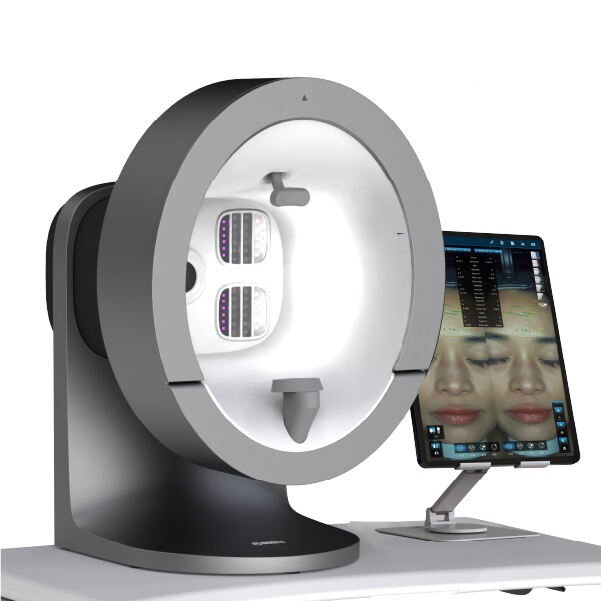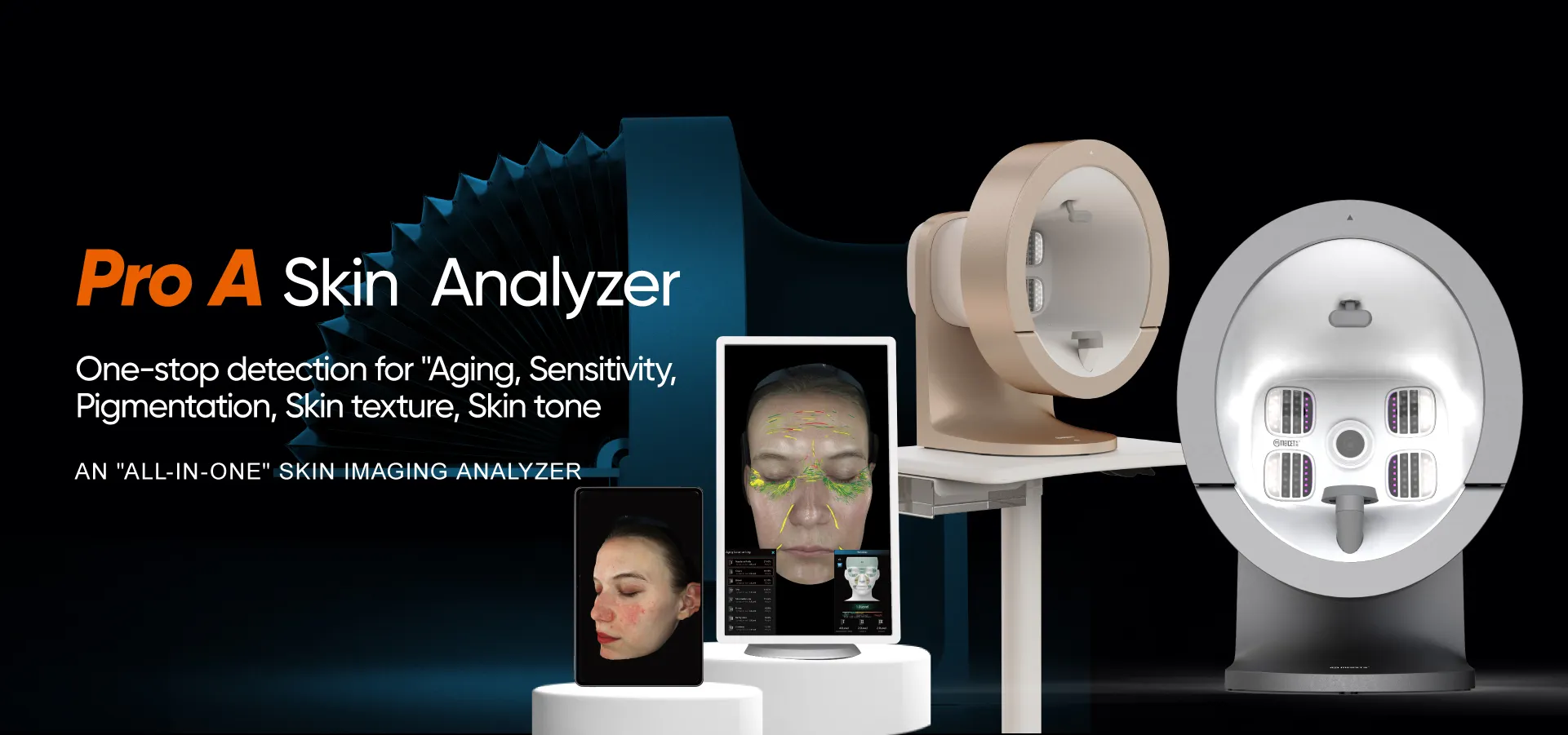
Le condizioni croniche della pelle sensibile - come dermatite atopica, rosacea persistente e dermatite seborroica - si caratterizzano per arrossamenti ricorrenti, intensità variabile dei sintomi e fattori scatenanti complessi che richiedono una gestione a lungo termine e proattiva. Queste condizioni necessitano sia di una diagnostica approfondita iniziale per stabilire un valore di base, sia di un monitoraggio continuo per tracciare le fluttuazioni, adattare i trattamenti e prevenire gli arrossamenti. I modelli tradizionali di cura spesso faticano a conciliare approfondimento e accessibilità, con diagnosi dettagliate limitate a cliniche specialistiche e follow-up vincolati alle visite in presenza.

Dalla diagnosi al valore di base con Pro-A
La Pro-A ’s imaging multi-spettrale e l'analisi AI creano un profilo dettagliato della pelle sensibile, catturando dettagli che guidano il trattamento iniziale:
- Mappatura della funzione barriera tramite imaging UV identifica zone di debolezza (es. guance nella dermatite atopica) rispetto alla relativa resistenza (es. fronte), permettendo un supporto mirato alla barriera.
- Valutazione dell'attività vascolare tramite luce polarizzata misura arrossamento e dilatazione dei capillari, fondamentale per sottotipi di rosacea—distinguendo casi lievi di ETR da casi gravi che richiedono intervento precoce con laser.
- Analisi di pigmento e texture tramite imaging RGB documenta iperpigmentazione post-infiammatoria (PIH), desquamazione o liquenificazione (ispessimento della pelle), comuni nella dermatite atopica cronica, per stabilire obiettivi realistici di miglioramento.
- Integrazione AI sintetizza questi parametri per generare un "punteggio di sensibilità", misurando la reattività complessiva della pelle e prevedendo i fattori scatenanti delle recidive (es. UV, stress o irritanti).
Un paziente con sospetta dermatite atopica effettua Pro-A valutazione:
- L'imaging UV mostra gravi irregolarità della barriera su guance e flessure.
- La luce polarizzata rivela un'arrossamento lieve e diffuso (infiammazione).
- L'imaging RGB conferma la lichenificazione sui gomiti.
- Il punteggio AI indica un'elevata reattività, con possibili attivatori previsti tra cui bassa umidità e prodotti profumati.
Questo baseline guida un piano iniziale: corticosteroidi topici su prescrizione per l'infiammazione attiva, idratante a base di ceramidi per la riparazione della barriera e l'evitare i fattori scatenanti identificati, con chiare metriche per misurare il successo.

Monitoraggio a Lungo Termine con MC10
Il MC10 estende questa cura anche negli ambienti remoti, permettendo un monitoraggio costante delle metriche chiave tra una visita in clinica e l'altra:
- Integrità della barriera tramite imaging UV monitora quanto efficacemente la pelle trattiene l'umidità, con scansioni regolari nei centri satellite che seguono la risposta ai prodotti idratanti o alle creme per la barriera. Un paziente affetto da dermatite atopica mostra un miglioramento dell'uniformità UV nel tempo (confermando che il suo idratante a base di ceramidi è efficace).
- Infiammazione tramite luce polarizzata rileva precocemente i segni di riaccensioni (arrossamento subclinico) prima che diventino sintomatici. Una successiva scansione MC10 di un paziente affetto da rosacea mostra un aumento dell'attività vascolare, che richiede un temporaneo aumento di topici antinfiammatori per prevenire un pieno riaccendersi.
- Pigmento e tessuto tramite imaging RGB monitora la risoluzione dell'iperpigmentazione post-infiammatoria o il miglioramento della liquenificazione, assicurando che trattamenti come illuminanti o esfolianti delicati siano efficaci.
Questo monitoraggio remoto intercetta la fiammata iniziale, evitando il peggioramento e riducendo le visite in ambulatorio.
Dati collaborativi per cure costanti
L'integrazione cloud garantisce Pro-A che i dati iniziali e le scansioni di follow-up MC10 siano accessibili a tutti i membri del team medico - dermatologi, infermieri specialisti e persino allergologi - creando un'unica scheda del paziente:
- Un dermatologo che esamina MC10 scansioni da un ambulatorio rurale può regolare la dose di steroidi di un paziente in base alle metriche dell'infiammazione rilevate con la luce polarizzata, garantendo continuità anche quando il paziente non può visitare l'ambulatorio principale.
- Un allergologo che consulta un paziente affetto da dermatite atopica e con sospetti trigger alimentari può fare riferimento ai dati sulla barriera UV Pro-A e MC10 ai modelli di peggioramento per identificare correlazioni tra alimentazione e salute della pelle.
- Un infermiere professionista che effettua un follow-up può confrontare le scansioni attuali MC10 con il valore iniziale Pro-A, verificando se gli obiettivi a lungo termine (ad esempio il miglioramento della barriera) vengono raggiunti.
Questa collaborazione elimina la frammentazione delle cure, un problema comune nella gestione delle condizioni croniche. Ad esempio, un paziente affetto da dermatite atopica visita periodicamente un dermatologo per Pro-A valutazioni e un infermiere professionista locale regolarmente per MC10 scansioni — entrambi accedono agli stessi dati per garantire che il piano terapeutico rimanga allineato.
La sinergia tra Pro-A e MC10 trasforma la gestione della pelle sensibile cronica da una serie di visite disconnesse a un percorso coerente basato sui dati. Combinando diagnosi iniziali approfondite con un monitoraggio accessibile e continuo, permettono ai professionisti sanitari di erogare una cura personalizzata e proattiva che riduce le recidive, migliora la qualità della vita e assicura che i pazienti si sentano supportati, che si trovino in una clinica specializzata o in un centro sanitario rurale.
 EN
EN
 AR
AR
 BG
BG
 HR
HR
 CS
CS
 DA
DA
 NL
NL
 FI
FI
 FR
FR
 DE
DE
 EL
EL
 HI
HI
 IT
IT
 JA
JA
 KO
KO
 NO
NO
 PL
PL
 PT
PT
 RO
RO
 RU
RU
 ES
ES
 SV
SV
 TL
TL
 IW
IW
 ID
ID
 SR
SR
 SK
SK
 SL
SL
 UK
UK
 VI
VI
 SQ
SQ
 HU
HU
 TH
TH
 TR
TR
 FA
FA
 AF
AF
 MS
MS
 UR
UR
 BN
BN
 LA
LA

